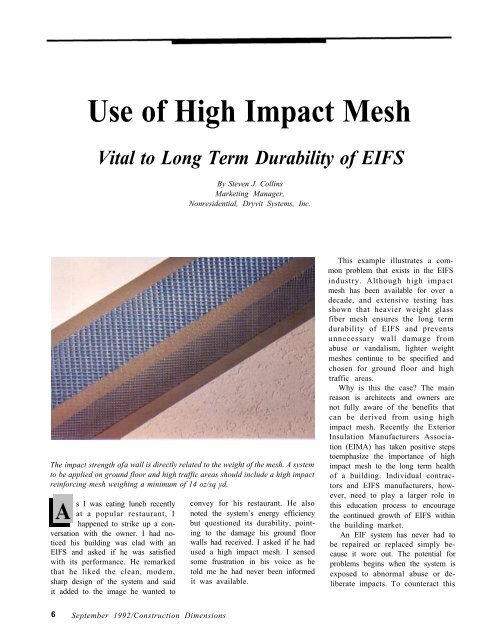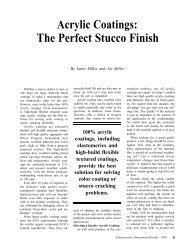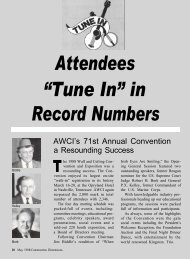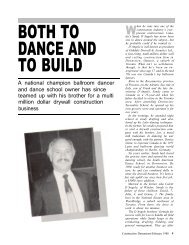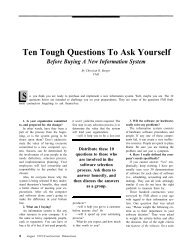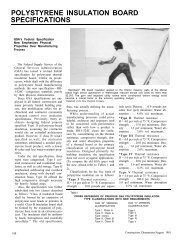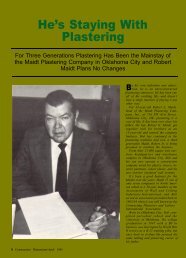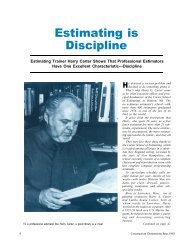Use of High Impact Mesh Vital to Long Term Durability of EIFS - AWCI
Use of High Impact Mesh Vital to Long Term Durability of EIFS - AWCI
Use of High Impact Mesh Vital to Long Term Durability of EIFS - AWCI
Create successful ePaper yourself
Turn your PDF publications into a flip-book with our unique Google optimized e-Paper software.
<strong>Use</strong> <strong>of</strong> <strong>High</strong> <strong>Impact</strong> <strong>Mesh</strong><br />
<strong>Vital</strong> <strong>to</strong> <strong>Long</strong> <strong>Term</strong> <strong>Durability</strong> <strong>of</strong> <strong>EIFS</strong><br />
By Steven J. Collins<br />
Marketing Manager,<br />
Nonresidential, Dryvit Systems, Inc.<br />
The impact strength <strong>of</strong>a wall is directly related <strong>to</strong> the weight <strong>of</strong> the mesh. A system<br />
<strong>to</strong> be applied on ground floor and high traffic areas should include a high impact<br />
reinforcing mesh weighing a minimum <strong>of</strong> 14 oz/sq yd.<br />
A<br />
s I was eating lunch recently<br />
at a popular restaurant, I<br />
happened <strong>to</strong> strike up a conversation<br />
with the owner. I had noticed<br />
his building was clad with an<br />
<strong>EIFS</strong> and asked if he was satisfied<br />
with its performance. He remarked<br />
that he liked the clean, modem,<br />
sharp design <strong>of</strong> the system and said<br />
it added <strong>to</strong> the image he wanted <strong>to</strong><br />
convey for his restaurant. He also<br />
noted the system’s energy efficiency<br />
but questioned its durability, pointing<br />
<strong>to</strong> the damage his ground floor<br />
walls had received. I asked if he had<br />
used a high impact mesh. I sensed<br />
some frustration in his voice as he<br />
<strong>to</strong>ld me he had never been informed<br />
it was available.<br />
This example illustrates a common<br />
problem that exists in the <strong>EIFS</strong><br />
industry. Although high impact<br />
mesh has been available for over a<br />
decade, and extensive testing has<br />
shown that heavier weight glass<br />
fiber mesh ensures the long term<br />
durability <strong>of</strong> <strong>EIFS</strong> and prevents<br />
unnecessary wall damage from<br />
abuse or vandalism, lighter weight<br />
meshes continue <strong>to</strong> be specified and<br />
chosen for ground floor and high<br />
traffic areas.<br />
Why is this the case? The main<br />
reason is architects and owners are<br />
not fully aware <strong>of</strong> the benefits that<br />
can be derived from using high<br />
impact mesh. Recently the Exterior<br />
Insulation Manufacturers Association<br />
(EIMA) has taken positive steps<br />
<strong>to</strong>emphasize the importance <strong>of</strong> high<br />
impact mesh <strong>to</strong> the long term health<br />
<strong>of</strong> a building. Individual contrac<strong>to</strong>rs<br />
and <strong>EIFS</strong> manufacturers, however,<br />
need <strong>to</strong> play a larger role in<br />
this education process <strong>to</strong> encourage<br />
the continued growth <strong>of</strong> <strong>EIFS</strong> within<br />
the building market.<br />
An EIF system has never had <strong>to</strong><br />
be repaired or replaced simply because<br />
it wore out. The potential for<br />
problems begins when the system is<br />
exposed <strong>to</strong> abnormal abuse or deliberate<br />
impacts. To counteract this<br />
6 September 1992/Construction Dimensions
threat <strong>of</strong> damage <strong>to</strong> ground floor<br />
and high traffic areas, high impact<br />
meshshould be applied <strong>to</strong> reinforce<br />
the base coat component <strong>of</strong> a typical<br />
EIF system and increase its impact<br />
resistance.<br />
Its use becomes a win/win situation<br />
for all involved--the owner,<br />
architect, contrac<strong>to</strong>r and manufacturer.<br />
The specially woven and<br />
treated mesh, when embedded in<br />
the base coat, enhances the long<br />
term performance and durability <strong>of</strong><br />
the system. Potential damage <strong>to</strong> the<br />
system is all but eliminated.<br />
The Contrac<strong>to</strong>r’s Role<br />
The contrac<strong>to</strong>r can help promote<br />
the use <strong>of</strong> high impact mesh by<br />
providing it as a recommended alternative<br />
in a bid if it’s needed but<br />
not specified. By educating the architect<br />
and building owner as <strong>to</strong> the<br />
benefits <strong>of</strong> high impact mesh and<br />
encouraging them <strong>to</strong> incorporate<br />
the proper material on the specifications,<br />
the chances <strong>of</strong> a successful<br />
project and greater acceptance <strong>of</strong><br />
<strong>EIFS</strong> within the building industry<br />
will be maximized.<br />
The successful contrac<strong>to</strong>r takes<br />
as much pride in the finished work<br />
as the architect does in the design<br />
and the manufacturer does in the<br />
materials. By using appropriate<br />
products for specific applications,<br />
such as high impact mesh for all<br />
ground floor and high traffic areas,<br />
the chances <strong>of</strong> the work standing<br />
the test <strong>of</strong> time are greatly increased.<br />
As a result, contrac<strong>to</strong>rs realize a<br />
reduction in the amount <strong>of</strong> callbacks<br />
for time-consuming repairs<br />
and an increase in their pool <strong>of</strong><br />
satisfied cus<strong>to</strong>mers--a benefit for<br />
future new business.<br />
For example, the unhappy restaurant<br />
owner I alluded <strong>to</strong> earlier<br />
might have wanted <strong>to</strong> use an <strong>EIFS</strong><br />
on the other buildings he owns if he<br />
was aware <strong>of</strong> the availability <strong>of</strong> high<br />
impact mesh. Now he may use a<br />
different building material which<br />
could be one less job up for bid.<br />
In these competitive times, it’s<br />
difficult, indeed, <strong>to</strong> recommend<br />
anything that will add <strong>to</strong> the cost <strong>of</strong><br />
a job. However, the minimal cost<br />
differential <strong>of</strong> high impact mesh will<br />
be more than <strong>of</strong>fset through building<br />
owner satisfaction. If cost cutting<br />
is needed <strong>to</strong> bring projects<br />
within budget, high impact mesh is<br />
not one <strong>of</strong> the areas whichshould be<br />
sacrificed.<br />
Manufacturers Need To Be<br />
Proactive<br />
Although the contrac<strong>to</strong>r can assist<br />
in voicing the importance <strong>of</strong><br />
high impact mesh, EIMA and the<br />
individual <strong>EIFS</strong> manufacturers need<br />
<strong>to</strong> take a strong leadership position<br />
If the high<br />
impact mesh is<br />
used by itself<br />
with no<br />
second layer<br />
the system will<br />
be much more<br />
susceptible<br />
<strong>to</strong> cracking.<br />
and educate the architectural and<br />
owner communities on its significance<br />
<strong>to</strong> the long term durability<br />
and efficiency <strong>of</strong> the system.<br />
Dryvit® Systems, Inc., realizing<br />
that optimum durability is <strong>of</strong> key<br />
importance <strong>to</strong> the system, has long<br />
been an advocate <strong>of</strong> the use <strong>of</strong> high<br />
impact glass fiber reinforcing mesh<br />
at all ground floor and high traffic<br />
areas. The company made a formal<br />
proposal <strong>to</strong> EIMA outlining its position<br />
and encouraging the association<br />
<strong>to</strong> adopt an easily definable<br />
high impact mesh standard.<br />
Benefits <strong>of</strong> the New EIMA<br />
Fiber <strong>Mesh</strong> Standard<br />
EIMA formulated and approved<br />
such a standard guide for the use <strong>of</strong><br />
resin-coated, glass fiber mesh in<br />
<strong>EIFS</strong>. The guide states that all ground<br />
floor applications and all facades<br />
exposed <strong>to</strong> abnormal abuse or deliberate<br />
impacts shall have the base<br />
coat reinforced with a double layer<br />
<strong>of</strong> glass fiber mesh consisting <strong>of</strong> a 14<br />
oz/sq yd minimum first layer and a<br />
4 oz /sq yd minimum second layer.<br />
The standard also states that this<br />
application should achieve a minimum<br />
mechanical stress resistance<br />
<strong>of</strong> 150 in.-lbs, according <strong>to</strong> EIMA,<br />
and 180 ft-lbs according <strong>to</strong> ASTM.<br />
The new standard takes a giant<br />
step <strong>to</strong>ward simplifying the performance<br />
measurement <strong>of</strong> high impact<br />
mesh for the architect by putting<br />
the emphasis on the product<br />
weight. The new standard measurement<br />
is based on the premise that<br />
the impact strength and durability<br />
<strong>of</strong> a wall is directly related <strong>to</strong> the<br />
weight <strong>of</strong> the mesh, which is determined<br />
by the number <strong>of</strong> glass fibers<br />
utilized in the manufacturing process.<br />
The higher the mesh weight,<br />
the better the wall will stand up <strong>to</strong><br />
abuse.<br />
In the past, these meshes have<br />
beendistinguished by manufacturer<br />
name and by inch pounds or foot<br />
pounds <strong>of</strong> performance. It was determined<br />
that manufacturers’ product<br />
names do not always provide<br />
proper references <strong>to</strong> the architect<br />
and that past measurements and<br />
test <strong>of</strong> impact strength, such as inch<br />
pounds or foot pounds, have been<br />
open <strong>to</strong> debate.<br />
Hopefully all manufacturers will<br />
introduce high impact mesh products<br />
with weight designations. Sales<br />
<strong>of</strong> Dryvit’s high impact mesh products,<br />
as a percentage <strong>of</strong> overall sales,<br />
have increased over the past year.<br />
And, there is further reason <strong>to</strong> be<br />
optimistic. Owners and architects<br />
are witnessing the effectiveness <strong>of</strong><br />
high impact mesh on completed<br />
projects.<br />
8 September 1992/Construction Dimensions
Application <strong>of</strong> <strong>High</strong><br />
<strong>Impact</strong> <strong>Mesh</strong><br />
For those jobs that do specify<br />
high impact mesh, it is the<br />
contrac<strong>to</strong>r’s responsibility <strong>to</strong> continue<br />
<strong>to</strong> apply it in the proper way.<br />
<strong>High</strong> impact meshes are the initial<br />
layer <strong>of</strong> mesh embedded in<strong>to</strong> the<br />
base coats. Edges <strong>of</strong> high impact<br />
mesh pieces should be tightly butted<br />
but not overlapped. After a minimum<br />
24-hour curing, examine for<br />
projections and correct them as necessary<br />
<strong>to</strong> project a flat surface. A<br />
layer <strong>of</strong> at least 4 oz mesh is then<br />
applied in<strong>to</strong> a second layer <strong>of</strong> base<br />
coat.<br />
It is important <strong>to</strong> follow the application<br />
procedures <strong>to</strong> the letter. If<br />
the high impact mesh is used by<br />
itself with no second layer the system<br />
will be much more susceptible<br />
<strong>to</strong> cracking. If a plasterer decides <strong>to</strong><br />
eliminate the second layer by overlapping<br />
the high impact mesh, the<br />
end result will be an uneven surface.<br />
Contrac<strong>to</strong>rs and <strong>EIFS</strong> manufacturers<br />
need <strong>to</strong> begin the process <strong>of</strong><br />
re-emphasizing the importance <strong>of</strong><br />
utilizing high impact mesh <strong>to</strong> architects<br />
and building owners so the<br />
<strong>EIFS</strong> industry can gain greater acceptance<br />
and continue <strong>to</strong> expand<br />
in<strong>to</strong> the 21st century.<br />
About the Author:<br />
Steven James Collins, marketing<br />
manager-nonresidential, for Dryvit<br />
Systems, Inc., West Warwick RI, is<br />
responsible for marketing the <strong>EIFS</strong><br />
manufacturer’s systems and products<br />
as well as developing new market<br />
opportunities for the company.<br />
Prior <strong>to</strong> his position at Dryvit,<br />
Collins was vice president <strong>of</strong> sales<br />
and marketing for Insul/Crete Co.<br />
Inc., Madison, WI, and regional sales<br />
manager at Sencon Systems, Inc.,<br />
Chicago, IL. He is a graduate <strong>of</strong> the<br />
University <strong>of</strong> Michigan, Ann Arbor,<br />
MI.<br />
For a copy <strong>of</strong> the EIMA Guide Standard<br />
101.9 “Standard Guide For <strong>Use</strong> <strong>of</strong> Resin<br />
Coated, Glass Fiber <strong>Mesh</strong> in Exterior<br />
Insulation and Finish Systems (<strong>EIFS</strong>),<br />
Class PB,” contact EIMA at 2759<br />
State Road 580, Suite 122, Clearwater,<br />
FL 34621, or call (813) 726-6477. q<br />
Mr. Collins<br />
Construction Dimensions/September 1992 9


